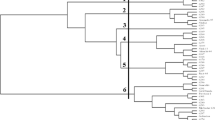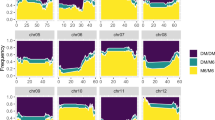Abstract
The objective of this study was to evaluate the entire set of 221 sugarcane microsatellite (SSR) markers from the International Sugarcane Microsatellite Consortium for their utility on molecular characterization of elite U.S. germplasm. Five elite U.S. sugarcane clones were tested, including two cultivars LCP 85-384 and HoCP 96-540 from Louisiana, two cultivars CP 72-1210 and CP 85-1308 from Florida, and Green German, an active parental clone used in both states. The 5’ ends of all forward primers were labeled with the fluorescent phosphoramidite dye, FAM and PCR-amplified DNA fragments detected using a semi-automatic capillary electrophoresis system. The sizes of DNA fragments were computed accurately by running genotyping software calibrated against 16 fluorescence-labeled DNA size standard fragments. Evaluation criteria included PCR robustness, extent of the presence of irregular peaks, and the polymorphism information content (PIC). Sixty-seven SSR markers (30% of the total) were found to be highly robust, with PIC values ranging from 56% to 80%. Of these, 40 (60%) markers contained dinucleotide repeats, 11 (16%) markers contained trinucleotide repeats, and 16 (24%) markers contained composite repeats. A total of 467 alleles were scored, of which 350 were polymorphic, averaging five polymorphic alleles per marker, with their sizes ranging from 80 to 460 bp. Several of these highly polymorphic SSR markers have proven useful in sugarcane germplasm evaluation, variety identity tests, cross fidelity assessment, and polycross paternity analysis.
Similar content being viewed by others
References
Aitken, K.S., Jackson, P.A. andMcIntyre, C.L. (2005). A combination of AFLP and SSR markers provides extensive map coverage and identification of homo(eo)logous linkage groups in a sugarcane cultivar.Theor. Appl. Genet.,110: 789–801.
Alwala, S., Suman, A., Arro, J.A., Veremis, J.C. andKimbeng, C. A. (2006). Target Region Amplification Polymorphism (TRAP) for Assessing Genetic Diversity in Sugarcane Germplasm Collections.Crop Sci.,46: 448–455.
Besse, P. and McIntyre, C.L. (1996). Molecular markers: Useful tools for sugarcane breeders.In Sugarcane: research towards efficient and sustainable production. J.R. Wilson, D.M. Hogarth, J.A. Campbell and A.L. Garside (Eds), pp57–58.
Besse, P., McIntyre, C.L. andBerding, N. (1996). Ribosomal DNA variations in Erianthus, a wild sugarcane relative (Andropogoneae Saccharinae).Theor. Appl. Genet.,92: 733–743.
Besse, P., Taylor G., Carroll, B., Berding, N., Burner, D. M. andMcIntyre, C. L. (1998). Assessing genetic diversity in a sugarcane germplasm collection using an automated AFLP analysis.Genetica,104: 143–153.
Breaux, R.D. andLegendre, B.L. (1983). The USDA Commercial breeding program in Louisiana. Proc. Inter-Amer.Sugar Cane, Sem.:Varieties and Breeding,III: 99–105.
Burner, D.M. and Legendre, B.L. (1993). Sugarcane genome amplification for the subtropics: a twenty year effort.Sugar Cane, 5–10.
Burner, D. M., Pan, Y-B andWebster, R. D. (1997). Genetic diversity of New World and Old World Saccharum assessed by RAPD Analysis.Genet. Res. Crop Evol.,44: 235–240.
Burnquist, W.B. (1991). Development and application of restriction fragment length polymorphism technology in sugarcane (Saccharum spp.) breeding. Ph.D. dissertation, Cornell Univ., Ithaca, NY.
Clark, J.M. (1988). Novel non-templated nucleotide addition reactions catalyzed by prokaryotic and eukaryotic DNA polymerases.Nucleic Acids Res.,16: 9677–9686.
Cordeiro, G.M., Taylor, G.O. andHenry, R.J. (2000). Characterisation of microsatellite markers from sugarcane (Saccharum sp.), a highly polyploid species,Plant Sci. 155: 161–168.
Cordeiro, G.M. andHenry, R.J. (2001). Evaluation of microsatellites (Simple Sequence Repeats) as genetic markers in sugarcane.Proc. Intl. Soc. Sugar Cane Technol.,24: 627–629.
Cordeiro, G.M., Casu, R., McIntyre, C.L., Manners, J.M. andHenry, R. J. (2001). Microsatellite markers from sugarcane (Saccharum sp.) ESTs transferable toErianthus and sorghum.Plant Sci. 160: 1115–1123.
Cordeiro, G.M., Pan, Y. B. andHenry, R.J. (2003). Sugarcane microsatellites for the assessment of genetic diversity in sugarcane germplasm.Plant Sci.,165: 181–189.
da Silva, J.A.G. (2001). Preliminary analysis of microsatellite markers derived from sugarcane expressed sequence tags (ESTs).Genet. Mol.Biol. 24(1–4): 155–159.
D’Hont, A., Lu, Y. H., Feldmann, P. andGlaszmann, J.C. (1993). Cytoplasmic diversity in sugar cane revealed by heterologous probes.Sugar Cane,1: 12–15.
D’Hont, A., Rao, P.S., Feldmann, P., Grivet, L., Islam-Faridi, N., Taylor, P. andGlaszmann, J.C. (1995). Identification and characterisation of sugarcane intergeneric hybrids,Saccharum officinarum xErianthus arundinaceus, with molecular markers and DNAin situ hybridisation.Theor. Appl. Genet.,91: 320–326.
Glaszmann, J.C., Noyer, J.L., Fautret, A., Lanaud, C. andFeldmann, P. (1989). Molecular genetic markers in sugarcane.Proc. Intl. Soc. Sugar Cane Technol.,2: 872–882.
Glaszmann, J.C., Lu, Y.H. andLanaud, C. (1990). Variation of nuclear ribosomal DNA in sugarcane.J. Genet. Breed.,44: 191–198.
Grivet, L., D’Hont, A., Roques, D., Feldmann, P., Lanaud, C. andGlaszmann, J.C. (1996). RFLP mapping in cultivated sugarcane (Saccharum spp.): Genome organization in a highly polyploid and aneuploid interspecific hybrid.Genetics,142: 987–1000.
Harvey, M. andBotha, F.C. (1996). Use of PCR-based methodologies for the determination of DNA diversity betweenSaccharum varieties.Euphytica,89: 257–265.
Jannoo, N., Forget, L. andDookun, A. (2001). Contribution of microsatellites to sugarcane breeding program in Mauritius.Proc. Intl. Soc. Sugar. Cane Technol.,24: 637–639.
Legendre, B.L. andBreaux, R.D. (1983). The USDA basic sugarcane breeding program in Louisiana. Proc Inter-Amer Sugar Cane Sem:Varieties and Breeding,III: 96–98.
Levinson, G. andGutman, G.A. (1987). Slipped-strand mispairing: a major mechanism for DNA sequence evolution.Mol. Biol. Evol.,4(3): 203–221.
Milbourne, D., Meyer, R., Bradshaw, J.E., Baird, E., Bonar, N., Provan, J., Powell, W. andWaugh, R. (1997). Comparison of PCR-based marker systems for the analysis of genetic relationships in cultivated potato.Mol. Breed,. 3: 127–136.
Ming, R., Liu, S. C., Lin, Y.-R., da Silva, J., Wilson, W., Braga, D., van Deynze, A., Wenslaff, T.F., Wu, K. K., Moore, P.H., Burnquist, W., Sorrels, M.E., Irvine, J.E. andPaterson, A.H. (1998). Detailed alignment ofSaccharum and sorghum chromosomes: comparative organization of closely related diploid and polyploid genomes.Genetics,150: 1663–1682.
Pan, Y. B., Burner, D. M. andLegendre, B. L. (2000). An assessment of the phylogenetic relationship among sugarcane and related taxa based on the nucleotide sequence of 5S rRNA intergenic spacers.Genetica,108: 285–295.
Pan, Y. B., Burner, D.M. andWei, Q. (2001). Developing species-specific DNA markers to assist in sugarcane breeding.Proc. Intl. Sugar Cane Technol.,24(II): 337–342.
Pan, Y. B., Burner, D. M., Ehrlich, K. C., Grisham, M. P. andWei, Q. (1997). Analysis of primer-derived, non-specific amplification products in RAPD-PCR.Bio Techniques,22(6): 1072–1074.
Pan, Y. B., Miller, J. D., Schnell, R. J., Richard Jr., R.P. and Wei, Q. (2003a). Application of microsatellite and RAPD fingerprints in the Florida sugarcane variety program.Sugar Cane International, 19–28.
Pan, Y. B., Cordeiro, G.M., Richard Jr.,E.P. andHenry, R.J. (2003b). Molecular genotyping of sugarcane clones with microsatellite DNA markers.Maydica,48: 319–329.
Pan, Y. B., Burner, D.M., Legendre, B.L., Grisham, M.P. andWhite, W.H. (2004). An assessment of the genetic diversity within a collection ofSaccharum spontaneum with RAPD-PCR.Genet. Res. Crop Evol.,51: 895–903.
Pinto, L.R., Oliveira, K.M., Ulian, E.C., Garcia, A.A.F. andde Souza, A.P. (2004). Survey in the sugarcane expressed sequence tag database (SUCEST) for simple sequence repeats.Genome,47: 795–804.
Piperidis, G., Christopher, M.J., Carroll, M.J., Berding, N. andD’Hont, A. (2000). Molecular contribution to selection of intergeneric hybrids beween sugarcane and the wild speciesErianthus arundinaceus. Genome,43:1033–1037.
Schlotterer, C. andTautz, D. (1992). Slippage synthesis of simple sequence DNA.Nuc. Acids Res.,20: 211–215.
Tai, P. Y. P. (1989). Progress and problems of intergeneric hybridization in sugarcane breeding.Proc. Inter-Am Sugar Cane Sem.,Vol. I: 391–395.
Tew, T.L. (2003). World sugarcane variety census — 2000.Sugar Cane Intl.: 12–18.
Tew, T.L., White, W.H., Grisham, M.P., Dufrene Jr.,E.O., Garrison, D.D. Veremis, J.C., Pan, Y. B., Richard Jr.,E.P., Legendre, B.L. andMiller, J.D. (2003). Registration of ‘HoCP 96-540’Sugarcane.Crop Sci. 45: 785–786.
Tew, T.L. andPan, Y. B. (2005). Molecular assessment of the fidelity of sugarcane crosses with high-throughput microsatellite genotyping.J. Amer. Soc. Sugar Cane Technol.,25: 119.
Weber, J.L. andMay, P.E. (1989). Abundant class of human DNA polymorphisms which can be typed using the polymerase chain reaction.Am. J. Hum. Genet. 44: 388–396.
Author information
Authors and Affiliations
Corresponding author
Rights and permissions
About this article
Cite this article
Pan, YB. Highly polymorphic microsatellite dna markers for sugarcane germplasm evaluation and variety identity testing. Sugar Tech 8, 246–256 (2006). https://doi.org/10.1007/BF02943564
Received:
Revised:
Published:
Issue Date:
DOI: https://doi.org/10.1007/BF02943564




